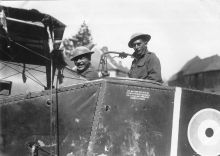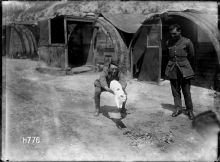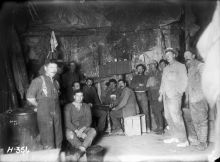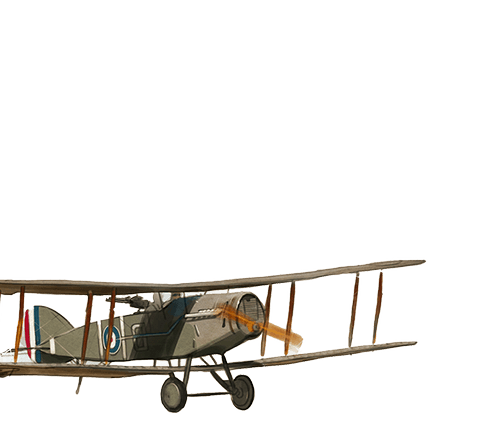Glossary
First World War & military vocabulary
Arras
Ace
Also known as an Air Ace or Flying Ace, these pilots became heroes and celebrities during the First World War. Technically, an ace was a military pilot credited with five or more kills. The first recognised ace was French pilot Adolphe Pégoud, but probably the most famous ace was Manfred von Richthofen - better known as the Red Baron.
Army
An operational unit composed of two or more Army Corps and supporting units, often numbering several hundred thousand men.
Army Corps
An operational unit composed of two or more divisions and supporting units, numbering 30-40,000 men.
Bloody April
Bloody April refers to the air battles fought over Arras in April 1917 between the Royal Flying Corps and the German Air Force, the Luftstreitkräfte. Out of the 365 aircraft gathered, the British lost 245, with 211 aircrew killed or missing. In comparison, the Germans recorded 66 aircraft lost.
Countermining
Mining operations consisting of tunnels and galleries dug under or alongside enemy positions for the purpose of placing explosives.
Division
Numbering over 18,000 men, in 1916 the New Zealand Division consisted of 3 infantry brigades, 4 field artillery brigades, a mounted rifles regiment and numerous smaller engineer, signals, medical, labour, logistic, trench mortar and machine gun units. Supporting the Division in a non-combat role was a large administrative and support structure composed of medical, training and administrative units.
Dogfight
An aerial fight between military pilots involving speed and manoeuvre.
Field Artillery Batteries and Brigades
New Zealand Field artillery batteries consisted of either six 18-pounder field guns or six 4.5-inch howitzers. A field artillery brigade consisted of 3 batteries of 18-pounders and 1 battery of 4.5-inch howitzers. By 1916 four such field artillery brigades were included in the New Zealand Division, in addition to 1 heavy, 3 medium and 3 light trench mortar batteries.
Flechette
A steel dart that can be thrown, dropped, or fired at an enemy, causing severe injury or death.
Flying Circus
The nickname of Jagdgeschwader 1, a fighter unit of the German Air Force commanded by Baron Manfred von Richthofen. The Flying Circus got their nickname due to the bright colours of their aircraft and their frequent travel around Europe to different airfields - like a travelling circus.
Gotha bomber
A First World War long-range heavy bomber built for and operated by the German Air Force. The Gotha was used mainly for night missions, carrying up to 14 25 kg bombs and was armed with up to three machine guns for defence against scouts or fighters.
Infantry Battalion
Infantry battalions were commanded by a lieutenant colonel and were composed of 4 companies. At full strength a battalion numbered over a thousand men, but would usually go into action with less than 800. After severe fighting battalion strengths could fall dramatically to as few as 300 or 400 men. Medical, signalling and logistics troops were also contained within a battalion.
Infantry Brigade
New Zealand Infantry brigades were composed of 4 infantry battalions and at full strength numbered over 4,000 men, commanded by a brigadier-general. Whereas British infantry brigades were reduced to only three battalions in 1918, New Zealand infantry brigades retained their 4-battalion strength throughout the war, making the New Zealand Division one of the strongest in the British and Commonwealth armies.
Infantry Company
Infantry companies were commanded by Majors or Captains and consisted of a small headquarters and 4 platoons, totalling about 227 men at full strength. 4 companies formed a battalion.
Infantry Sections and Platoons
The smallest tactical unit within an infantry battalion, the infantry section consisted of 12 men led by a non-commissioned officer. At the beginning of the war almost all infantry sections were composed exclusively of riflemen, but by 1918 they also contained specialised bombing and light-machine-gun personnel. 4 Sections were normally required to form an Infantry platoon commanded by a junior officer.
Light rail
A transport system similar to trams, involving the transportation of lighter loads at a faster rate. Often used for transporting people in urban centres, light rail was used extensively during the First World War to transport people, supplies, and ammunition both above and below ground.
Recce
A slang word simply meaning ‘reconnaissance’ or ‘reconnoitre’, a recce is a survey of a location by an individual or group to obtain information.
Siege warfare
A prolonged battle where an army fights an enemy who are defending a static position. Siege warfare often involves a high level of creativity where innovative tactics and new weapons are trialled, with each side looking to gain the advantage.
Supply column
An essential part of an army’s operations and logistics, a supply column carries everything that an army needs to sustain fighting, advancing, or retreating. This includes food, ammunition, weapons, medical equipment, clothing, and other necessary items.
Squadron
(Army) Usually made up of two or more troops, a squadron is a counterpart to an artillery battery or infantry company. (Air force) A squadron is a military air unit consisting of 12 to 24 planes.
The Red Baron
Manfred von Richthofen was a German fighter ace during the First World War and commander of Jagdgeschwader 1, also known as the ‘Flying Circus’. Named the ‘Red Baron’ after his bright red Fokker Dr.I triplane, Richthofen was known for his skill in the air and successful tactics in engaging the enemy. Shot down and killed over Amiens, France, in April 1918, Richthofen was buried with full military honors by the Allies. He was credited with 80 victories and is arguably the best known ace in history.
Vauban
Sébastien Le Prestre de Vauban (1633-1707) was a Marshal of France and the most skilled engineer of his time. Vauban became famous for designing complex fortifications and was an expert in building and defending structures, as well as besieging them. Advising Louis XIV, Vauban designed and oversaw the construction of France’s border fortifications during the 17th century.
Zeppelin airship
Zeppelin airships were developed in Germany by Count Ferdinand von Zeppelin in the 1890s and first put to commercial use in 1910. During the First World War, Germany used Zeppelins for reconnaissance and bombing raids.



